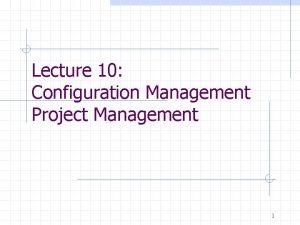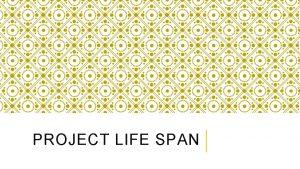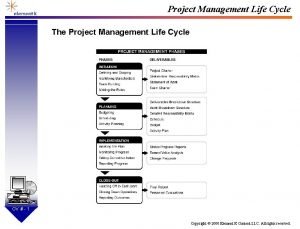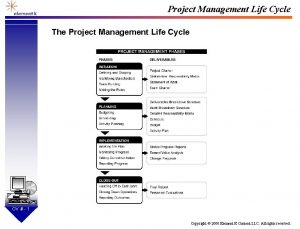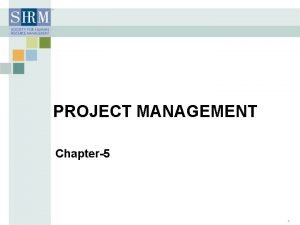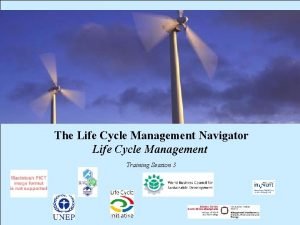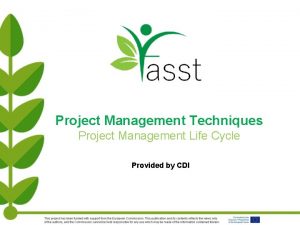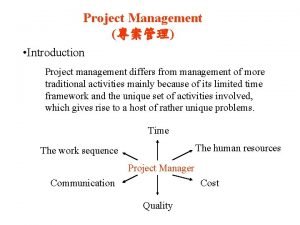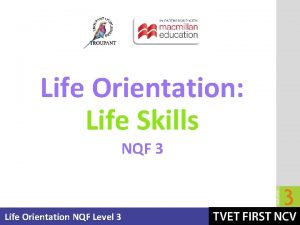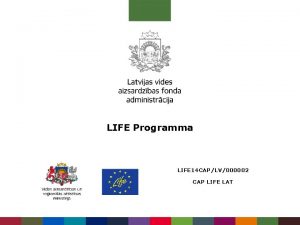Project Management What is a project Project life
















- Slides: 16

Project Management What is a project? Project life cycle? Process Risk management Time management Why do projects fail? EXAMPLE Cartoon EXAMPLE Project

What is a Project? • Temporary endeavor with defined beginning and end time • Not routine or “business as usual” • Has a clear goal • Has a deadline • Often requires combination of people and their specialist knowledge

Project Life Cycle

Goal Setting 1# Make sure your goal is clear. It needs to be SMART: • • • Specific – clearly defined goal Measurable – able to track progress and success Attainable – realistic chance of aspired outcome Relevant – achieves what you want it to achieve Time-bound – has a start and end time

Process of project management • Initiate • Plan • Carry out/execute • Monitor • Close

What are the risks? • What is risk management in a project? A risk is the possibility of an event or condition that would have a negative impact on a project. Risk management is the process of identifying, mitigating, and controlling the known risks in order to increase the probability of meeting your project objectives. • Kinds of risk People – What other people do is outside your control and communication, authority and personality types may all affect your project Approvals – Red tape like laws and University policy could slow down your project Procurement – You may have trouble with sellers, items and finding suitable material with your budget Time – Things may take longer that you expect and there may only be small windows of opportunity for certain tasks External factors – uncontrollable change that is outside your control

What are the risks? • What is risk management in a project? A risk is the possibility of an event or condition that would have a negative impact on a project. Risk management is the process of identifying, mitigating, and controlling the known risks in order to increase the probability of meeting your project objectives. • Risk mitigation People – Try and maintain good communication between people so you can monitor progress Approvals – Research and talk to all the people you need to as soon as possible Procurement – Source your materials early and have back-up suppliers, document all purchases and buy safely Time – Give yourself plenty of time, more than you need if you can External factors – If you can, give yourself a back-up plan. If A fails, have B ready as a substitute

Risk Management Process Identify Risk Analyze Risk Respond to Risk Document Risk

Time management Be prepared for things to take longer than they need to. You don’t need to see the future in order to plan ahead and consider the issues you might face that might cause delays.

What do projects fail? • Lack of solid project plan = Make sure your proposal is clear • Poor communication = Talk to us about what you need to achieve and update us often • Bad decisions = Don’t rush decisions if you can help it, take time to weigh the options • Unrealistic timeframes and tasks = Be realistic and research what tasks will take the most time • Lack of organisational support = Show us you have a good idea and solid plan and there should be no problem with this – but be persuasive! • Under-estimated costings = Research your costs • Poor implementation or quality = Better no project than one of poor quality

What do projects fail: famous example • Walkie-Talkie skyscraper building in London melts cars on the sidewalks after concave shape of design reflects light onto bonnets. • The design was flawed from the beginning – tests were either not done or not done well • Architect didn’t learn from his mistake – one of his buildings had done this before!

Pyramid Cartoon

Example Project: Swift boxes initial idea Sarah wanted to increase campus biodiversity She took her natural interest and read around on urban nature and wildlife She discovered there was a swift population in Leicester and these birds were struggling to find nest sites She researched online and found innovative ideas and companies that were also trying to tackle this problem – the solution was an artificial nest boxes specially designed for them

Example Project: Swift boxes research and planning She set up a meeting with an Environment Team member and they gave her the opportunity present a power point with her ideas She looked up the potential costs of the boxes, what was the best way to encourage swifts to nest and what was needed to get them up there e. g. scaffolding. She also spoke to experts in that field. She identified the potential problems that might occur by looking at when the swifts started breeding (when the boxes needed to be up by) and if it would effect the building users in any way.

Example Project: Swift boxes implementing and communicating Although scaffolding was needed to install the boxes, Sarah discovered by presenting to the team that scaffolding was already going to be put up on one of the suitable buildings for another reason. She kept in contact with the person assigned to help her often and made sure they knew why they were doing it and they gave her help with the more technical aspects. Sarah documented everything and made sure to write-up, publicise and thank everyone involved for helping her.

Don’t suffer in silence! Be sure to come talk to us if you feel you need help at any stage. We can’t do anything if we don’t know what your struggling with – come see us early.
 Introduction to software project management
Introduction to software project management Life cycle phases in software project management
Life cycle phases in software project management Top management and middle management
Top management and middle management Management pyramid
Management pyramid Top management and middle management
Top management and middle management Managing assets vs asset management
Managing assets vs asset management Configuration management project management
Configuration management project management Basic principles of cost management
Basic principles of cost management Define configuration management
Define configuration management Example of project integration management
Example of project integration management The role of project management in achieving project success
The role of project management in achieving project success Modern project profiles in software project management
Modern project profiles in software project management Project cost-duration graph
Project cost-duration graph Introduction to project management kathy schwalbe
Introduction to project management kathy schwalbe Project evaluation in software project management
Project evaluation in software project management Types of project audit in project management
Types of project audit in project management Microsoft project agile template
Microsoft project agile template






